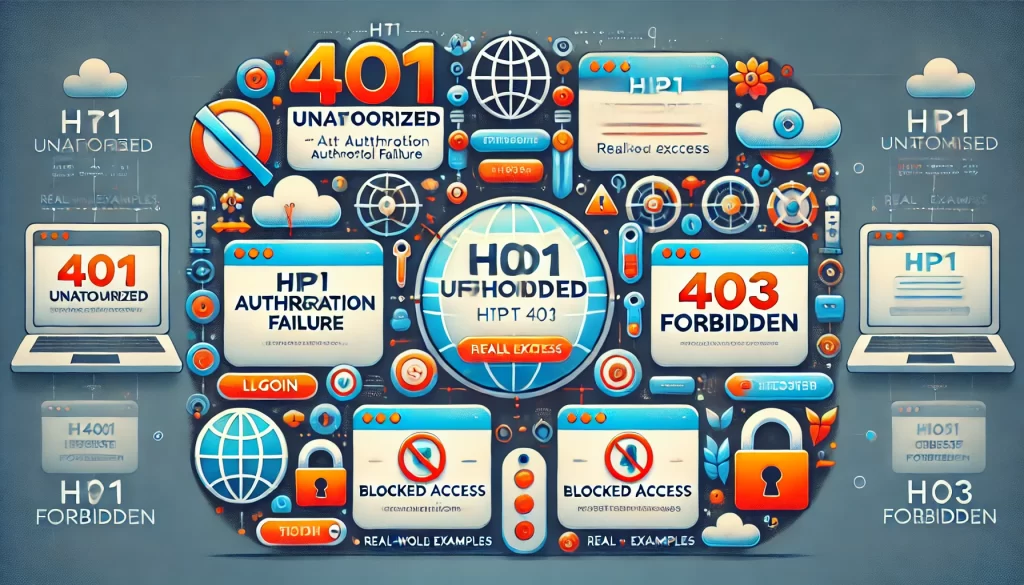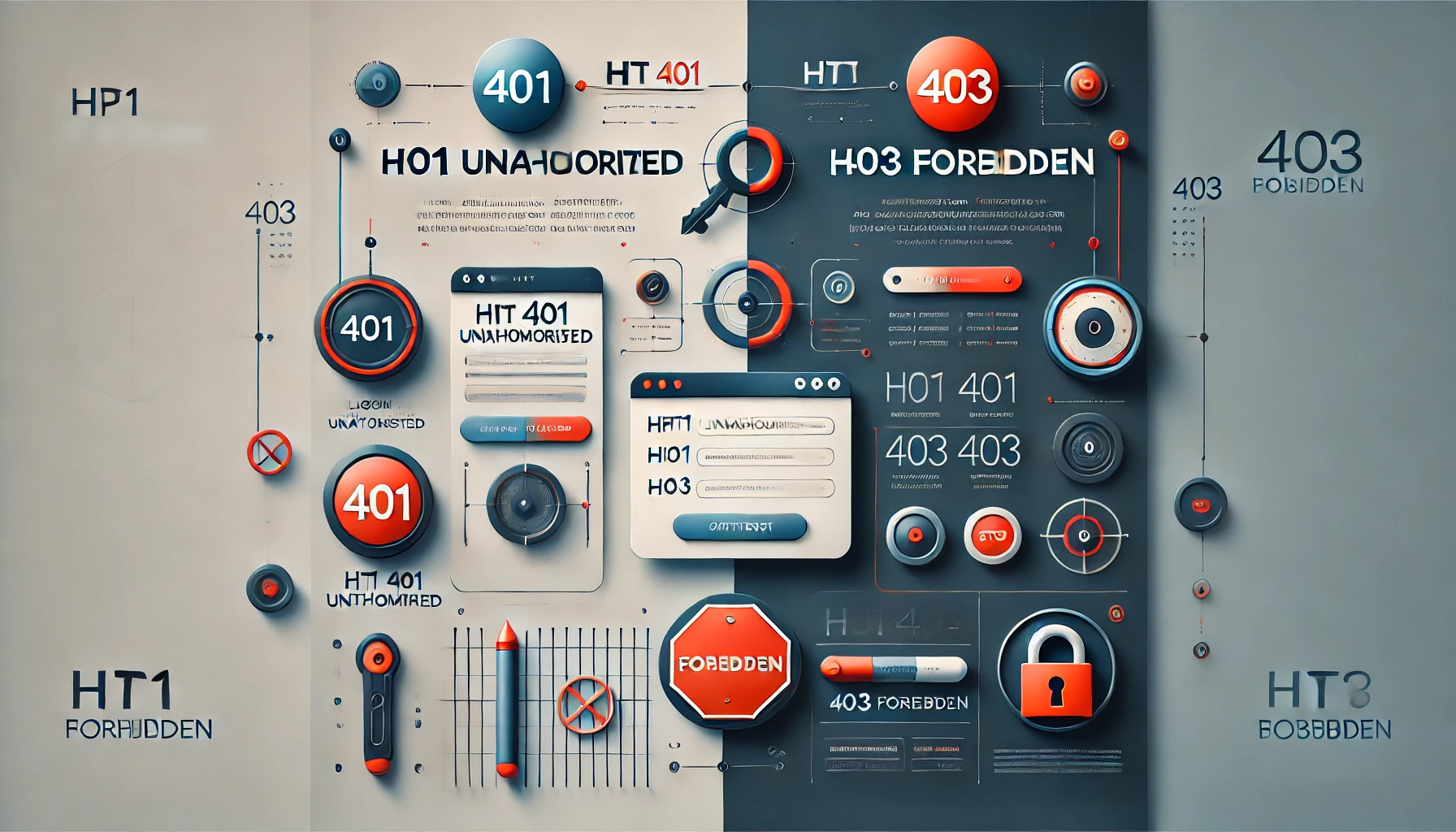Introduction
HTTP status codes are essential for understanding communication between web servers and clients. Among the 4xx client error codes, 401 Unauthorized and 403 Forbidden are often misunderstood and confused. While both indicate access issues, their meanings and use cases differ significantly. Explain the differences between HTTP 401 and HTTP 403, including their definitions, causes, solutions, and when to use each in web development scenarios.

Why 401 and 403 Are Often Confused
Both HTTP 401 and HTTP 403 errors deal with access restrictions, making it easy to mix them up. However, their key difference lies in the role of authentication and permissions:
- HTTP 401 Unauthorized: Indicates that authentication is required or invalid.
- HTTP 403 Forbidden: This means the user is authenticated but lacks permission to access the resource.
To make informed decisions during development, it’s essential to distinguish these errors and handle them appropriately.
Related Posts
- HTTP Status Codes Cheat Sheet
- HTTP 403 Forbidden: Meaning, Causes, and Fixes
- HTTP 401 Unauthorized: Everything You Need to Know
Side-by-Side Comparison
| Aspect | HTTP 401 Unauthorized | HTTP 403 Forbidden |
| Definition | Authentication is required or invalid. | Authentication is valid, but access is denied due to lack of permissions. |
| Common Causes | – Missing credentials- Expired tokens- Incorrect API keys | – Restricted resource- Insufficient role permissions- IP-based blocking |
| Response Header | Often includes WWW-Authenticate to request credentials. | Does not include WWW-Authenticate. |
| HTTP Status Code | 401 | 403 |
| When Used | For login-required pages or APIs. | For restricted content or unauthorized user roles. |
| Fix for Users | Provide correct credentials or log in. | Contact the administrator for access permissions. |
Definitions, Causes, and Fixes for Each
HTTP 401 Unauthorized
Definition
The HTTP 401 status code indicates that the client must authenticate itself to get the requested resource.
Common Causes
- Missing Authentication: The user didn’t provide credentials.
- Invalid Credentials: Incorrect username or password.
- Expired Token: Authentication tokens have expired.
- Incorrect API Configuration: Misconfigured API keys or tokens.
Fixes
- For Users: Log in using valid credentials or refresh expired tokens.
- For Developers: Ensure proper authentication mechanisms, such as OAuth, are implemented.
HTTP 403 Forbidden
Definition
The HTTP 403 status code means the server understands the request but refuses to authorize it.
Common Causes
- Insufficient Permissions: The user’s role lacks the required access rights.
- Restricted Resources: The server prevents access to specific directories or files.
- IP Blocking: Access is denied based on geographical or IP restrictions.
- Security Policies: Firewalls or plugins block unauthorized activity.
Fixes
- For Users: Request access from the administrator.
- For Developers:
- Review user permissions.
- Adjust server configurations, including .htaccess rules.
- Ensure proper file and directory permissions.

When to Use 401 vs 403 in Development
API Authentication Examples
401 Unauthorized: Use when an API request is missing authentication credentials or when credentials are incorrect.
Example:
Http
CopyEdit
HTTP/1.1 401 Unauthorized
WWW-Authenticate: Basic realm=”Access to API”
403 Forbidden: Use when the user lacks permissions despite valid credentials.
Example:
Http
CopyEdit
HTTP/1.1 403 Forbidden
Content-Type: application/json
{ “error”: “You do not have access to this resource.” }
Website Access Scenarios
- 401 Unauthorized: Protect login-required areas, such as dashboards or member-only sections.
- 403 Forbidden: Restrict access to admin panels for unauthorized roles or block IPs from certain regions.
Real-World Examples
Example 1: Admin Panel Access
- 401 Unauthorized: A user attempts to access the admin panel without logging in.
- 403 Forbidden: A logged-in user tries to access the admin panel but lacks the admin role.
Example 2: API Token Validation
- 401 Unauthorized: An API request is made without an authentication token.
- 403 Forbidden: The token is valid, but the associated account lacks permission to access specific API endpoints.
Example 3: File or Directory Access
- 401 Unauthorized: A user tries to access a restricted file on a website without proper login credentials.
- 403 Forbidden: A logged-in user attempts to access a directory restricted by server settings.
Related Posts
- HTTP 503 Service Unavailable Explained
- HTTP 401 vs 403: Key Differences
- Frequently Asked Questions – HTTP Status Codes
FAQs
What is the main difference between HTTP 401 and 403 errors?
401 errors indicate missing or invalid authentication, while 403 errors mean authentication is valid, but the user lacks permission.
Can HTTP 401 and 403 errors affect SEO?
Yes. Pages that return frequently 401 or 403 errors may negatively impact search engine crawling and indexing. Properly managing access restrictions is crucial for SEO.
How can developers debug HTTP 401 errors?
Check authentication mechanisms, such as tokens or login credentials. Use tools like Postman or server logs for debugging.
What should I do if I encounter an HTTP 403 error?
Contact the website administrator to request access or verify that your IP or role is authorized.
Are HTTP 401 and 403 errors client-side or server-side?
Both are server-side responses caused by client-side actions, such as missing credentials or unauthorized access attempts.
What tools can help troubleshoot HTTP 401 and 403 errors?
Server logs, API testing tools like Postman, and browser developer tools help diagnose these errors.
Key Takeaways
The HTTP 401 Unauthorized and HTTP 403 Forbidden status codes play distinct roles in managing access control on websites and APIs. While both indicate access issues, understanding their differences ensures proper error handling and user experience.
For developers, applying these codes appropriately is essential for creating secure and intuitive systems. For users, recognizing the cause of these errors can help resolve access problems efficiently.
- HTTP 401 Unauthorized: Indicates missing or invalid authentication credentials.
- HTTP 403 Forbidden: Denotes access denial despite valid authentication.
- Key Difference: 401 focuses on authentication, while 403 focuses on permissions.
- Fixes: Ensure proper authentication mechanisms and review permissions for users and resources.
